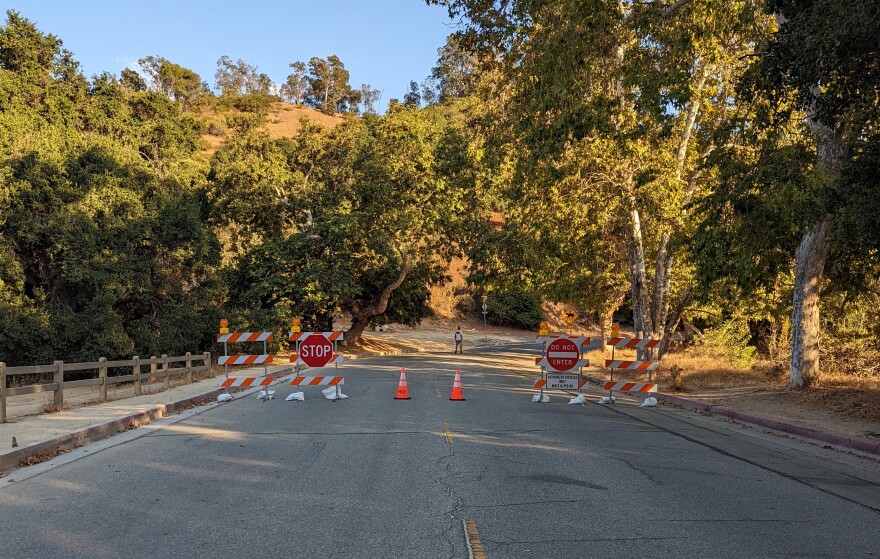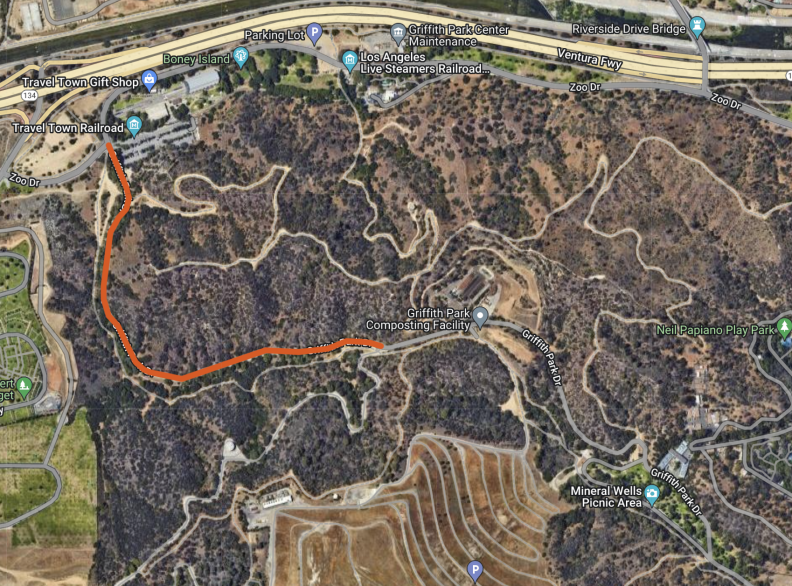That Car Ban In Griffith Park Is Now Permanent — And More Road Changes Are On The Way

The car ban on a short stretch of road in Griffith Park that started out as temporary is now here to stay. The city of L.A.’s Board of Recreation and Parks Commissioners voted unanimously on Thursday to make the ban permanent.
Back in late June, a ⅔ mile section of Griffith Park Drive was closed to car traffic from the Travel Town Museum to Mt. Hollywood Drive. The road had become a popular route for speeding drivers looking to avoid slowdowns on the nearby 134 and 5 freeways. That made the park a dangerous place for the people walking, biking, riding horses or otherwise enjoying the public space as intended.
City Councilmember Nithya Raman, who oversees Griffith Park as part of the city’s 4th Council District, had already been exploring ways to improve traffic safety in the park. But those efforts were fast-tracked after cyclist Andrew Jelmert, 77, was killed by a driver there in April.
“I am so excited to bring the road revolution home to Council District 4,” Raman said in a news release. “Our office, in partnership with the Department of Recreation and Parks, worked with lightning speed to make this closure along Griffith Park Drive a reality, and we have been overwhelmed with the outpouring of support from the community.”
Reaction From Safety Advocates
-
Introducing a new series: LAist City Treks
-
Why you won't find the best sunscreens here
-
New video shows alleged assault
Compared to the vast road network in L.A., the short span of asphalt that’s closed to cars is pretty minor. But safety advocates are celebrating it as a big win in car-centric L.A., where reclaiming space for people has been an uphill battle.
For Eli Akira Kaufman, executive director of the L.A. County Bicycle Coalition, the decision reaffirms that “Griffith Park is for the community, not the commute.”
“At a minimum, our parks must prioritize the well-being of people who visit for a peaceful walk or bicycle ride without fearing for their lives,” he said in a news release. “The decision to reduce the number of vehicles speeding through the park is a good step toward preventing the next needless traffic violence tragedy.”

Additional Short-Term Plans
The car ban isn’t the only change coming to Griffith Park. Raman’s office has shared a multi-phase plan to add more short-term safety improvements to roads in and around the park, focusing on Crystal Springs Drive, Griffith Park Drive and Zoo Drive. The car ban on Griffith Park Drive is Phase One, followed by:
- Phase Two: Installing speed humps and speed feedback signs
- Phase Three: Creating a “road buffet” on Crystal Springs Drive and adding bike lanes to Zoo Drive
That “road buffet” would reconfigure the existing roadway, removing a car lane in each direction to create space for new dedicated bike and pedestrian lanes, plus new buffer space for drivers. There would also be new crosswalks and traffic calming installed on Crystal Springs Drive at the entrance to the park.

Stella Stahl, spokesperson for Raman’s office, said the community feedback has been “overwhelmingly positive.”
“The majority of people felt like they were finally able to bike along the pathway with their children and not really feel fearful for their lives and that the park was really being restored to its original intention,” she told LAist.
Upgrades Down The Road
Further upgrades are planned, categorized as mid-term and long-term, though there’s no current timetable for how long parkgoers will have to wait to see them. Those include more labor-intensive work like repaving and adding new physical protections on streets in the park.
Stahl said the strategy to divide upgrades into short-, medium- and long-term projects helps the city “make progress as quickly as possible on improvements that we know aren't a massive financial lift.”
It also helps that these roads are controlled solely by L.A.’s Department of Recreation and Parks, reducing the bureaucratic hurdles that have plagued other street projects in the city.
“Things take a notoriously long time in the city, but we got this (car ban) done in truly rapid time,” she said. “We are trying to capitalize on that momentum to move forward and really get the ball rolling on all of these other projects as soon as possible.”
⭐ Join us THIS Friday 8/19, 4-7 PM! ⭐
— Councilmember Nithya Raman (@cd4losangeles) August 15, 2022
We’ll be celebrating with FREE food + rides at Travel Town, a community walk/bike/equestrian ride, and…an exciting update on the future of Griffith Park!
RSVP: https://t.co/X8HI8muzjv pic.twitter.com/YrduUGbMuK
-
The project will rename most of the terminals and all of the gates with the goal of world-class signage that leans into psychology.
-
The highly anticipated airport service likely won’t open until October 2025.
-
Big Sur's Highway 1 was built to maximize the breathtaking views of the cliffs and ocean at the cost of the road's longterm stability.
-
You can take the test in the comfort of your own home, twice.
-
The location in East Hollywood is the fourth official crosswalk to replace Crosswalk Collective LA's "unauthorized" efforts. Other DIY crosswalks have been removed by city officials.
-
Step one: Pull out that phone and snag photos of the pothole and car damage.









